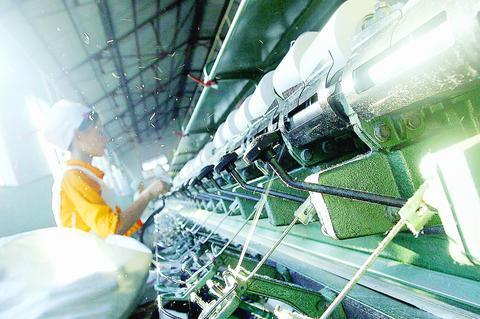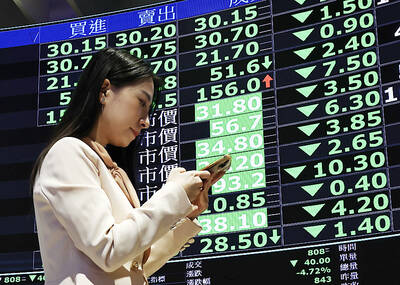China overtook the US as a top global destination for foreign direct investment (FDI) last year while the Asia-Pacific region attracted more investment than any other developing region, a UN report said last week.
China's strong manufacturing industry helped the country attract FDI last year worth US$53.5 billion, compared with US$52.7 billion in 2002, the UN Conference on Trade and Development (UNCTAD) said in its annual report on investment flows.

PHOTO: EPA
Meanwhile, foreign investment in the US, traditionally the largest recipient of such money, plunged by 53 percent last year to reach US$30 billion, the lowest level in 12 years, according to data from UNCTAD's World Investment Report 2004.
Flows to the Asia-Pacific region as a whole rebounded over the year to US$107 billion from US$94 billion in 2002 driven by strong economic growth and a better investment environment, the agency said.
China was expected to continue to attract foreign companies, analysts said.
"According to our analysis, FDI in China has not peaked although their economic growth rates have fallen," UNCTAD economist James Zhan told journalists.
The outbreak of SARS only had a marginal downward effect on investment activity as Asia emerged from the decline in foreign investment it had experienced since 2001, the report noted.
"Prospects for a further rise in foreign direct investment flows to Asia and the Pacific in 2004 are promising," UNCTAD's Deputy Secretary General, Carlos Fortin, said in a statement.
But the distribution of the new wealth was uneven across the region, with most of the money -- US$72 billion -- concentrated in north-east Asia. Flows to south-east Asia rose 27 percent to US$19 billion, while the south merely received US$6 billion in FDI.
Resource-rich central Asia recorded US$6.1 billion, and US$4.1 billion flowed into the west.
The manufacturing sector remained the dominant factor that pulled investment into China, but a rise in investment in the services industry was noted elsewhere in line with the global trend, UNCTAD said.
Services, including finance, tourism, telecommunications and information technology, formed a growing proportion of foreign direct investment stock in the region -- up to 50 percent in 2002, the most recent figure available, from 43 percent in 1995, UNCTAD said.
UNCTAD said the growing tendency to shift some business activities overseas to places where labor costs are low but the workforce is skilled helped to raise the region's profile.
Asian companies were also growing in power and reach as investors in other regions, according to the Geneva-based agency.
China and India were joining Malaysia, South Korea, Singapore and Taiwan as sources of foreign direct investment, it said.
Asian firms, such as Hutchinson Whampoa of Hong Kong, Singapore's Singtel and Samsung of South Korea, again dominate the UNCTAD list of the top companies from the developing world.

TARIFFS: The global ‘panic atmosphere remains strong,’ and foreign investors have continued to sell their holdings since the start of the year, the Ministry of Finance said The government yesterday authorized the activation of its NT$500 billion (US$15.15 billion) National Stabilization Fund (NSF) to prop up the local stock market after two days of sharp falls in reaction to US President Donald Trump’s new import tariffs. The Ministry of Finance said in a statement after the market close that the steering committee of the fund had been given the go-ahead to intervene in the market to bolster Taiwanese shares in a time of crisis. The fund has been authorized to use its assets “to carry out market stabilization tasks as appropriate to maintain the stability of Taiwan’s

STEEP DECLINE: Yesterday’s drop was the third-steepest in its history, the steepest being Monday’s drop in the wake of the tariff announcement on Wednesday last week Taiwanese stocks continued their heavy sell-off yesterday, as concerns over US tariffs and unwinding of leveraged bets weighed on the market. The benchmark TAIEX plunged 1,068.19 points, or 5.79 percent, to 17,391.76, notching the biggest drop among Asian peers as it hit a 15-month low. The decline came even after the government on late Tuesday authorized the NT$500 billion (US$15.2 billion) National Stabilization Fund (國安基金) to step in to buoy the market amid investors’ worries over tariffs imposed by US President Donald Trump. Yesterday’s decline was the third-steepest in its history, trailing only the declines of 2,065.87 points on Monday and

TARIFF CONCERNS: The chipmaker cited global uncertainty from US tariffs and a weakening economic outlook, but said its Singapore expansion remains on track Vanguard International Semiconductor Corp (世界先進), a foundry service provider specializing in producing power management and display driver chips, yesterday withdrew its full-year revenue projection of moderate growth for this year, as escalating US tariff tensions raised uncertainty and concern about a potential economic recession. The Hsinchu-based chipmaker in February said revenues this year would grow mildly from last year based on improving supply chain inventory levels and market demand. At the time, it also anticipated gradual quarter revenue growth. However, the US’ sweeping tariff policy has upended the industry’s supply chains and weakened economic prospects for the world economy, it said. “Now

Six years ago, LVMH’s billionaire CEO Bernard Arnault and US President Donald Trump cut the blue ribbon on a factory in rural Texas that would make designer handbags for Louis Vuitton, one of the world’s best-known luxury brands. However, since the high-profile opening, the factory has faced a host of problems limiting production, 11 former Louis Vuitton employees said. The site has consistently ranked among the worst-performing for Louis Vuitton globally, “significantly” underperforming other facilities, said three former Louis Vuitton workers and a senior industry source, who cited internal rankings shared with staff. The plant’s problems — which have not